The local Complex Weavers rep had organised three Denise Kovnat workshops in a row, but I only signed up to the first one initially. Having enjoyed it, not suffered too much physically, and after looking at my calendar, I figured I could do the third if it was still possible. It was, so I signed up, got the documentation, ordered yarn and warped the Lotas.
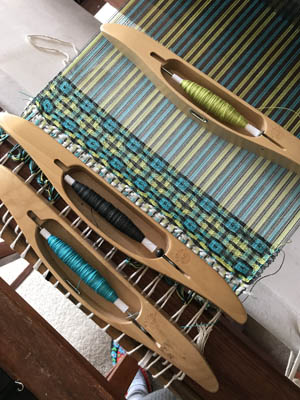
After the first workshop day of three sessions, I got weaving. The warping had been a lot faster than Echo, and the weaving was too even though it required two to four shuttles for the sampler drafts Denise provided. I tore through the first three, cut them off the loom and fulled them.
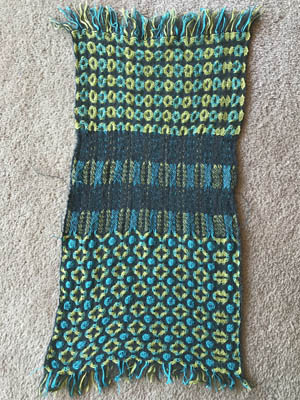
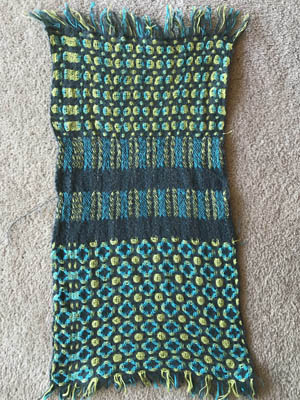
Only then did I notice a threading error. But I liked the way it looked and decided to keep it.
I continued weaving and by the second trio of classes the following workshop day I had the first one done and had started on the second. Between the classes I wove more, and would have finished all three if I hadn’t needed to stop and wind a bobbin.
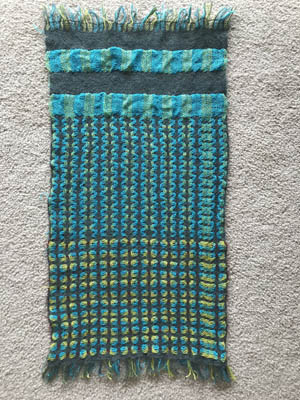
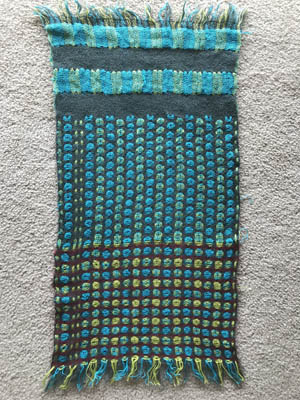
Only three or four of the students had woven anything, because most were still finishing the project from the middle workshop. This was a bit disappointing, as I didn’t get to see a variety of samplers from different 8-shaft drafts to ones using more.
After the second day of classes I finished the second trio of samples, cut them off the loom and fulled them, using laundry soap. The fulling wasn’t happening as fast as it had the first time, and I realised I’d used woolmix previously. So I changed the water and added woolmix, and oh boy did that full! No wonder why my knitwear has been shrinking the last few years! That brand of woolmix has now been relegated to machine washable clothing or things I want to full.
With a week left, I decided to weave my favourite of the six drafts using the alternative yarns Denise had suggested we play with. My notes follow the pics.
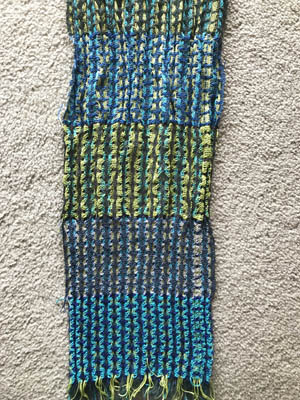
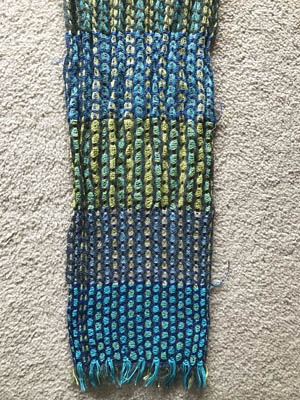
1a dark blue Colcolastic instead of the grey merino, original blue 10/2 cotton.
1b original grey merino, lilac Colcolastic instead of the cotton.
RESULT: Colcolastic created an even texture on both samples that pulled in more than the merino shrinks. 1b creates the zig-zag effect better.
2a burgundy wool & stainless steel instead of the merino, yellow-green 10/2 cotton.
2b dark blue 10/2 cotton instead of the merino, pale green silk stainless steel instead of the cotton.
RESULT: Crinkle effect is more random but pulled in the same rate as the Colcolastic. Feels soft and a bit papery.
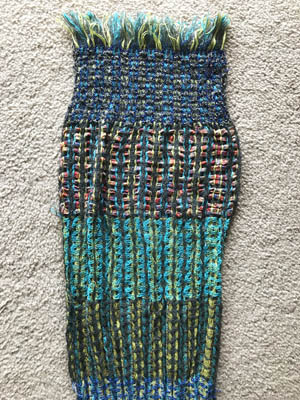
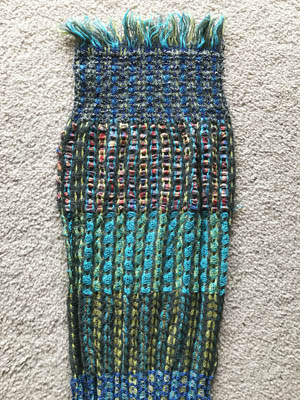
3a original grey merino, gold gimp instead of the cotton.
3b gold gimp instead of the grey merino, original blue cotton.
RESULT: Pulled in a little less than Colcolastic and stainless steel. Surprisingly soft for a metallic.
4a original grey merino, multicolour tape yarn instead of the cotton.
4b grey and black tape yarn instead of the merino, dark blue Colcolastic instead of the cotton.
RESULT: 4a had the same shrinkage on first two trios of samplers, which is less than the other yarns. The zig-zag is completely lost but it’s still a lovely effect and feel that would make a beautiful scarf or shawl. 4b shrank more – the same as the other Colcolastic samples – and lost the zig-zag. It’s is more like a messy plaid, which is okay but a waste of an expensive tape yarn.
That left me with about half a metre of warp left. I thought I might try tweaking the tie-up and treadling, but decided to wait until after the next class in case Denise had other suggestions. Then an email from the rep reminded us that Denise would no longer be available for questions after the third workshop so I figured I may as well keep going in case what I tried raised some issues.
It took a few days before I got back to the loom, however, as I came down with a really terrible headache. Possibly a migraine. I’ve been having these weekly, usually on a Monday and Tuesday, but this time it hung around most of the week. I did eventually manage to play a bit in Fiberworks and stumbled upon a horizontal version of the zig-zag draft I’d used for the alternative yarns. Which was the same on the front as the back. So I used that to worked out how to change the original so it was also same on both sides.
This suggested to me a scarf that switched back and forth from vertical zig-zag to horizontal. However, the gap between them didn’t translate to the back, and the two together used 12 pedals when I only have 10. But then I noticed that two sets of the treadles were very similar, so I could add and remove four pegs when I switched from vertical to horizontal and back. So long as the blocks of each were big, it wouldn’t be too much trouble.
So I got weaving, finished the warp, took the piece off the loom… and realised I’d forgotten that I had altered the threading slightly to get the vertical zig zag to be reversible. Never mind! I fulled the fabric and have a nice piece long enough to be a cowl.
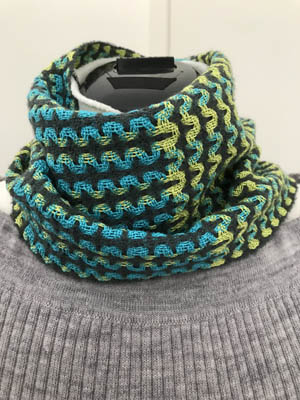
If I had 16 shafts perhaps I could do this as a grid pattern. Maybe something to try if I ever get around to making that 16 shaft table loom.
Of the two workshops, I enjoyed the Echo and Jin one more for the interaction between the participants. Of the two weave structures, I enjoyed the Deflected Doubleweave slightly more. Overall, I have learned a great deal, tried a whole lot of new yarns, and my to-do list of things to make has grown. I hope to do more workshops, but that may depend on what I end up doing next year. Which is not going to quite be what I had planned. But I’ll leave that to another post.
